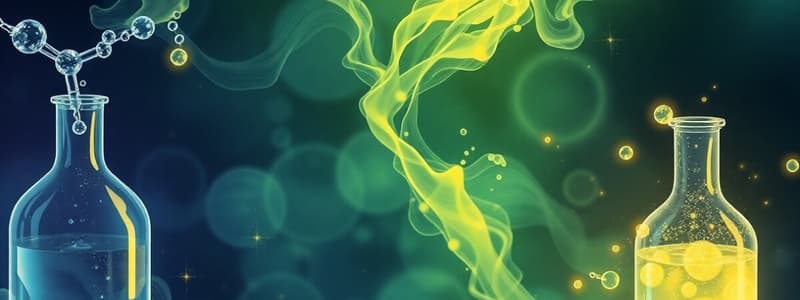Podcast
Questions and Answers
What gas is evolved when dilute sulphuric acid reacts with a reactive metal like magnesium?
What gas is evolved when dilute sulphuric acid reacts with a reactive metal like magnesium?
- Sulfur dioxide
- Carbon dioxide
- Hydrogen (correct)
- Oxygen
What happens to lime water when carbon dioxide is passed through it?
What happens to lime water when carbon dioxide is passed through it?
- It becomes clear
- It changes color to yellow
- It turns milky (correct)
- It bubbles
Which gas evolved from the reaction of dilute sulphuric acid and a sulphide turns lead acetate paper black?
Which gas evolved from the reaction of dilute sulphuric acid and a sulphide turns lead acetate paper black?
- Hydrogen sulphide (correct)
- Hydrogen
- Sulfur dioxide
- Ozone
What gas is produced when dilute sulphuric acid is added to a carbonate such as sodium bicarbonate?
What gas is produced when dilute sulphuric acid is added to a carbonate such as sodium bicarbonate?
What is indicated by the evolution of a colourless gas that turns lime water milky and has a suffocating smell?
What is indicated by the evolution of a colourless gas that turns lime water milky and has a suffocating smell?
Flashcards
Reaction of metal with sulfuric acid
Reaction of metal with sulfuric acid
A reactive metal will react with dilute sulfuric acid, producing hydrogen gas.
Reaction of carbonate/hydrogen carbonate with sulfuric acid
Reaction of carbonate/hydrogen carbonate with sulfuric acid
Carbonates and hydrogen carbonates react with sulfuric acid to release carbon dioxide gas.
Reaction of sulfide with sulfuric acid
Reaction of sulfide with sulfuric acid
Sulfides react with sulfuric acid to produce hydrogen sulfide gas, which has a rotten egg smell.
Reaction of sulphite with sulfuric acid
Reaction of sulphite with sulfuric acid
Signup and view all the flashcards
Identifying Unknown Substance
Identifying Unknown Substance
Signup and view all the flashcards
Study Notes
Dilute Sulphuric Acid Reactions
-
Reaction with metals:
- Dilute sulfuric acid reacts with reactive metals (e.g., magnesium, zinc, iron) to produce hydrogen gas.
- Effervescence (fizzing) occurs.
- The hydrogen gas produced produces a "pop" sound when ignited.
-
Reaction with carbonates/hydrogen carbonates:
- Dilute sulfuric acid reacts with carbonates or hydrogen carbonates to release carbon dioxide gas.
- The carbon dioxide gas turns limewater milky (cloudy).
- Carbon dioxide has no effect on acidified potassium dichromate paper.
-
Reaction with sulphides:
- Dilute sulfuric acid reacts with sulfides to produce hydrogen sulfide gas.
- Hydrogen sulfide has a foul (rotten egg) smell.
- Hydrogen sulfide turns lead acetate paper black.
-
Reaction with sulphites:
- Dilute sulfuric acid reacts with sulphites to produce sulfur dioxide gas.
- Sulfur dioxide has a suffocating, burning sulfur smell.
- Sulfur dioxide turns limewater milky (cloudy).
- Sulfur dioxide turns acidified potassium dichromate paper green.
Studying That Suits You
Use AI to generate personalized quizzes and flashcards to suit your learning preferences.
Description
Test your knowledge on the reactions of dilute sulphuric acid with various substances including metals, carbonates, sulfides, and sulphites. Explore how these reactions produce gases such as hydrogen, carbon dioxide, hydrogen sulfide, and sulfur dioxide, and understand the characteristics of each gas. This quiz will enhance your understanding of acid-base chemistry and gas identification.



